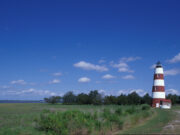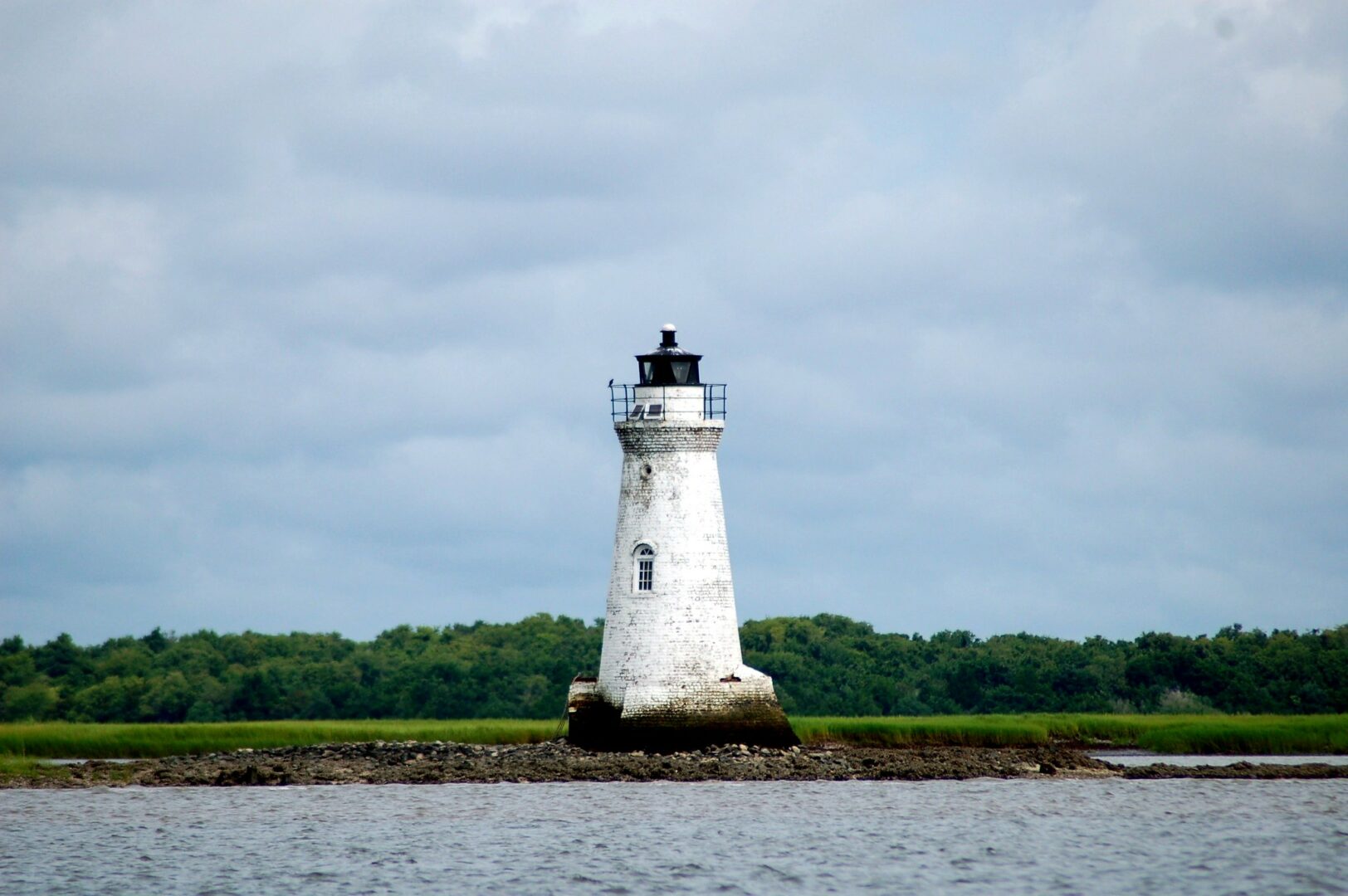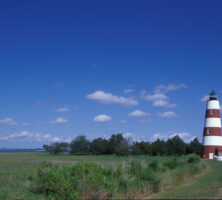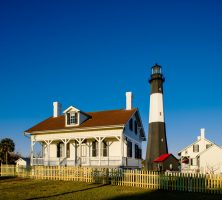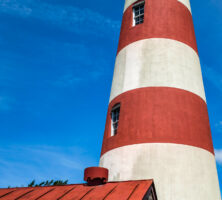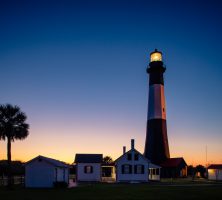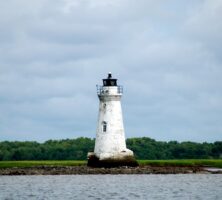When British general James Oglethorpe landed on Georgia’s coast in 1733, he realized that the success of his new colony, Savannah, depended largely on its establishment and development as a commercial port. Only three years later, in 1736, the first lighthouse was built in Georgia. Of the fifteen lighthouses built along Georgia’s ever-changing coastline, only five remain, three of which have functional lights.
Tybee Island Light
Located at the mouth of the Savannah River, the Tybee Island Lighthouse was the first on Georgia’s coast. Erected in 1736 and standing only 90 feet high, this structure served as a day mark for ships coming into the port of Savannah. It was, unfortunately, built too close to shore and was toppled by a severe storm in 1741. Rebuilt in 1742 again too close to the sea, this second structure suffered the same fate. A third tower, 100 feet high and constructed of brick, was completed in 1773 at a site farther back from the ocean. In 1790 the Tybee Lighthouse joined the federally operated U.S. Lighthouse Establishment. Using large candles with large metal discs as an illuminate for the lantern room, Tybee changed its status from day mark to lighthouse.
In 1822 a second, shorter lighthouse was built on Tybee Island adjacent to the first. By sailing to a position where the two lighthouses were aligned, a mariner could accurately approach the Savannah River channel. This system of two lights is called range lights.
By 1857 a second-order Fresnel lens was installed in the main lighthouse. Invented in 1823, the Fresnel lens produces a bright beam by concentrating and magnifying light, which can be seen up to eighteen miles out to sea. First- and second-order lenses (the largest) are used on seacoasts and are called landfall lights; third- and fourth-order lenses signal harbor entrances; and fifth- and sixth-order lenses (the smallest) mark rivers and channels. The light produced by the Fresnel lens was so brilliant that in 1861, when Union troops occupied Tybee, Confederates stationed nearby at Fort Pulaski were sent to burn the lighthouse’s wooden stairs and landings. The Union soldiers repaired the damage, however, and used the tower until the surrender of Fort Pulaski in 1862. Four years later a new lighthouse was built, using the lower sixty feet of the 1773 structure as a foundation. Activated in 1867, this 154-foot tower was reclassified as a major aid to navigation and required three keepers to staff the station.
Once the light was converted to electricity in 1933, there was no longer a need for three keepers. Maintained by the U.S. Coast Guard until 1987, this lighthouse remains one of America’s most intact light stations, with all its historic support structures still on site. The station is now maintained by the Tybee Island Historical Society and is open to the public.
Cockspur Island Light
Located two miles west of Tybee Island Lighthouse on Cockspur Island, the first Cockspur Lighthouse was built in 1849 and used to mark the entrance to the south channel of the Savannah River. This structure proved inadequate and was rebuilt in 1857. A twin channel-beacon was constructed at the same time on the north channel of the Savannah River. Built of Savannah gray brick, the lighthouse was fitted with a fourth-order Fresnel lens and illuminated by a sperm oil lamp. Unlike many lighthouses of the South, this small beacon received only minor damage during the Civil War (1861-65). After the war, the light resumed operation until 1909, when ships with deep drafts were no longer able to use the south channel. The U.S. Coast Guard abandoned the property in 1949, and control was transferred to the National Park Service.

Image from Dizzy Girl
Sapelo Island Light
During the early nineteenth century, the small seaport of Darien was a major shipping center. A deed signed and dated in 1808 by plantation owner Thomas Spalding showed that Spalding sold a small tract of land to the U.S. Lighthouse Establishment for a sum of one dollar for building a lighthouse on Sapelo. The government then contracted with Winslow Lewis of Boston in 1820 for the construction of a 90-foot brick tower, topped by a 15-foot iron lantern. A fourth-order Fresnel lens was installed atop the tower in 1853. The lighthouse was abandoned in 1862 by retreating Confederate forces stationed on the island. They removed the lens and destroyed the reflector system but left the rest of the facility intact. It was repaired and reactivated by the U.S. Lighthouse Service in 1868. In 1877 a cast-iron beacon, part of the range light system, was placed east of the main tower.
A severe hurricane in October 1898 seriously undermined the foundation of the Sapelo Lighthouse. A district inspector recommended extensive repairs or a new tower. In September 1905 a new lighthouse—a 100-foot steel pyramidal tower with a kerosene-lit flashing light—was activated and a new third-order lens was installed. By 1934 shipping traffic had become nonexistent and the Sapelo station was deactivated. Today, the lighthouse is fully restored and open to the public.
St. Simons Island Light
Built by James Gould in 1810, the first St. Simons Lighthouse stood 75 feet high. For economic reasons, most of the material used in the construction was tabby, a local mixture of oyster shell, lime, sand, and water. Gould, appointed by U.S. president James Madison, was also the first lighthouse keeper. In 1857 a third-order double-convex lens was installed.
Confederate troops destroyed the lighthouse before evacuating St. Simons Island in 1862, so that Union troops could not use it as a navigational aid. In 1867 the government ordered the construction of a second lighthouse placed north of the first. The 104-foot brick tower and adjacent keeper’s house was designed by the Irish architect Charles B. Cluskey, who died of malaria in 1871, a year before the lighthouse was completed. The head light keeper, his assistant, and their families shared the dwelling.
The lighthouse was electrified in 1934. It was completely automated in 1953. The original third-order Fresnel lens is still in operation. The station, maintained by the Coastal Georgia Historical Society, is open to the public.
Little Cumberland Island Light
The Little Cumberland Island Lighthouse is located on the northern tip of Little Cumberland Island in St. Andrew Sound. The tower, built in 1838 by John Hastings of Boston, measures 22 feet wide at the base, tapering to 11 feet wide at the top. Although rarely used during the Civil War, the lighthouse on Little Cumberland escaped the devastation experienced by some of the other Georgia lighthouses at the time. In 1867 it was reactivated after being fitted with a third-order Fresnel lens.
Nine years later, workmen began to shore up the lighthouse tower foundation, which had been undermined by ocean tides. Active until 1915, Little Cumberland Island Light is now owned and preserved by a private foundation.


